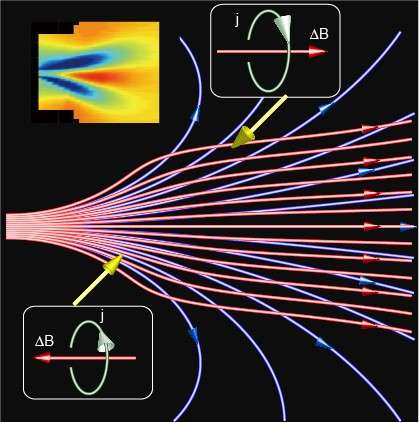On the road to creating an electrodeless spacecraft propulsion engine

The universe is made up of plasma, which is easily influenced by magnetic fields and forces, leading to complex behavior. Plasmas are found throughout the solar system in places such as the planetary magnetosphere, solar wind and in the tails of comets.
Magnetic fields stretched by plasma flows result in an increase in the field component along the plasma flow. These fields are frequently observed in space. By contrast, scientists in terrestrial laboratories often see the magnetic fields decreased by plasma due to its diamagnetism. This implies that the plasma can generate a magnetic field in the opposite direction to the one applied so the field lines diverge.
Researchers from Tohoku University have been trying to find out how the plasma flow is influenced by its environment via laboratory experiments, and have made headway on research toward an electrodeless plasma thruster to propel spacecraft.
There are many methods of spacecraft propulsion, and while they all have their pros and cons, electric propulsion is now mature and widely used. Electrically powered plasma thrusters can deliver large thrust density without the need to expose electrodes to plasma, which cuts down on damage from erosion over time.
While nearly all spacecraft use chemical rockets for launch, once the hardware is in space, propulsion is needed to manoeuvre the craft for orbit maintenance, supply missions and space exploration. Here, electric propulsion, with its higher exhaust speed, is preferred, as it typically uses less propellant than chemical rockets. Because it's difficult to make general repairs on spacecraft once they have left Earth, the reliability of their internal components is essential for long-term missions.
Some new concepts for plasma thrusters involve an expanding magnetic field called magnetic nozzle (MN), where the plasma is spontaneously accelerated to propel a spacecraft when exhausted into space.
The MN-induced force propelling the spacecraft has been demonstrated in laboratory experiments and originates in the plasma inducing the magnetic field in the opposite direction to the one applied. This works like magnets with facing N poles: one will repel the other. In the same way, the plasma in the propulsive MN essentially diverges the magnetic field. But because the magnetic fields are closed and turned back toward the spacecraft, the plasma, influenced by the field, turns back, making the net thrust zero.
To overcome this problem, researchers propose a scenario in which the magnetic field lines are stretched to infinity by the plasma flow. Until now, most laboratory experiments have focused on the diverged MN rather than the stretched field.
In their laboratory at Tohoku University, Kazunori Takahashi and Akira Ando successfully observed the spatial transition between the two plasma states diverging and stretching the MN. Here, they identified the transition when the stretching of the field was detected in the downstream region of the MN, whereas the plasma state diverging the MN (i.e., thrust generation by the MN) was still maintained in the upstream region of the MN.
This result might imply that the plasma flow can direct the magnetic field into space while maintaining the thrust generation by the MN. Although the stretch of the magnetic field has been thought to occur when the plasma flow reaches a specific velocity, called the Alfven velocity, the experiment shows that it actually occurs at a slower velocity than expected.
The variation of the field strength is only a few percent of the applied magnetic field strength for now, but this is a significant first step to overcoming the problem of detaching the plasma from the MN in the plasma thruster. Furthermore, this experiment provides some clues about the behaviour of plasma in different environments, bridging the gap between the lab and the natural world.
Further detailed experiments on a wide range of parameters, theoretical modeling and numerical simulation are still needed.
Detailed information can be found in the paper published by Â鶹ÒùÔºical Review Letters.
More information: Laboratory Observation of a Plasma-Flow-State Transition from Diverging to Stretching a Magnetic Nozzle, Kazunori Takahashi and Akira Ando, Â鶹ÒùÔºical Review Letters,
Journal information: Â鶹ÒùÔºical Review Letters
Provided by Tohoku University




















